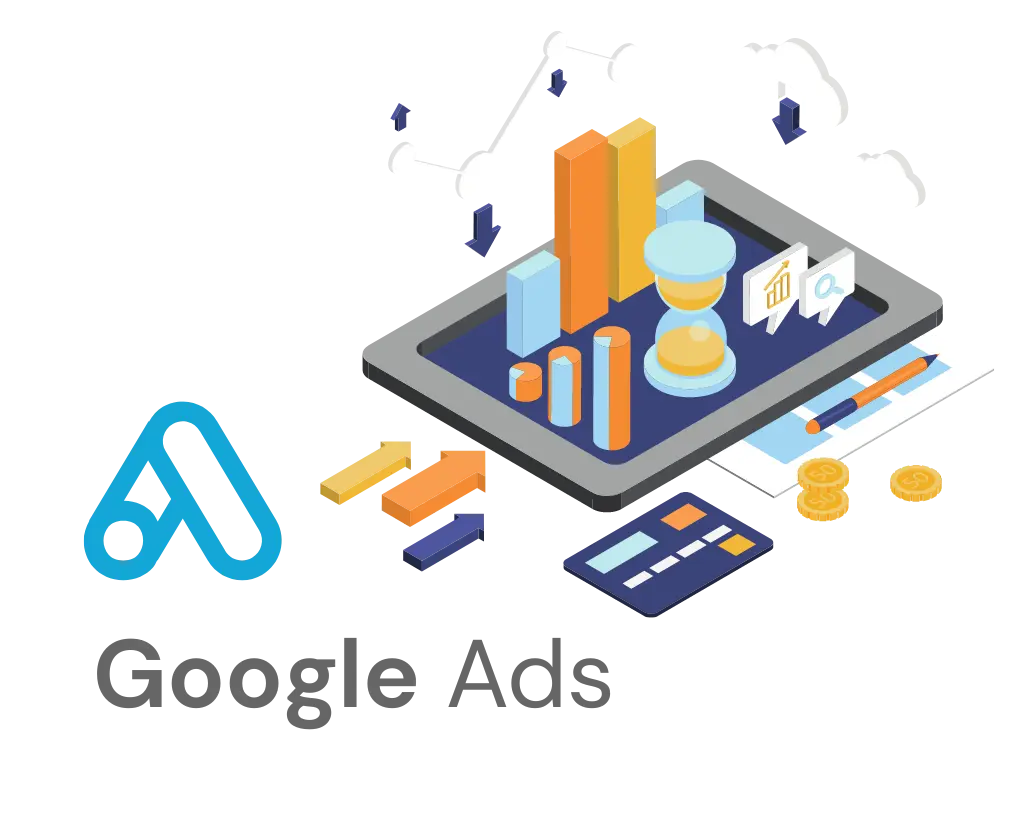Utilize Google Ads Management Services Affordably and Effectively
At Gigabit, we assist you in setting up your Google Ads Campaign, PPC (Pay-Per-Click) Campaign, Keyword Searches, and Landing Pages to grow your business via Google Ads Management Services at affordable advertising budgets. We boost your conversion rates and create highly effective paid search campaigns.


Google Ads Services
Get the best Google Ads Services from Gigabit at the best rates within your budget. We drive your product or service sales propelled by our digital strategies, that cater to your business needs and potential
Our Google Ads Management Services branch out as follows:
- Researching and planning keywords as per industry trends
- Analyzing competitor ads and their results
- Budgeting for campaigns as per cost-per-click (CPC) metric
- Creating landing pages
- Setting up campaigns, creating ad copies, and optimizing when needed
- Checking Conversion rates with CPC analysis
- Maintaining and evaluating the ads campaign creation cycle with Google Analytics
With the comprehensive but customized aforesaid services, you can enjoy the best ROI against your ad spend.
Google Ads Campaign for Nonprofits, Startups, and Starters
Previously Google Adwords management services, we provide Google Ads Management services to strategize and develop digital marketing campaigns for startups and nonprofits. We manage the whole application and registration process for Google for Nonprofits through our Google Ad Grants Management services of ours.
Please check out our Google Grants Management page, here, to avail this service at your convenience and needs.

Our Ads Management Service For You
Whether you are a startup or a nonprofit organization, we tailor our strategies and advertisement execution based on your needs and potential customers. We understand all campaigns vary as per industry or business. But we make sure, our PPC Campaigns and Campaign Management help grow your business and boost your customer conversion rates.
Keywords Are The “Key Words”
Google Ads (previously Google Adwords) is the online or digital advertising platform from Google that lets you select the right ad messages and ad copies from a variety of searches, driven by appropriate, market-relevant keywords. These keywords are the keys to attracting your potential customers who visit your website pages (or landing pages) by clicking on the ads of their choice. Once they enter your website for their solutions, they become your leads for a potential long-term customer source of sales and income.
To leverage and enhance the power of Google Ads, we continuously conduct keyword research to help grow your business. Whether at the very start of our process or as an after-sales service, we continually optimize your search results by identifying negative keywords and including the most appropriate keywords to drive your sales or leads. As we garner visitors to your website via industry analysis, competitor analysis, appropriate keyword research, and ad campaign creation, your business gets the much-needed boost within a reasonable budget.
Campaigns and Copies That Convert
Gigabit creates campaigns for you that enhance your conversion rates. We ensure this by writing fool-proof, expert-approved ad copies. And the process does not stop there. We regularly optimize your ad deliverables by enriching your keywords and setting flexible strategies as per the latest trends.
With a focus on flawless, flexible, and future-proof pay-per-click (PPC) advertising and paid search advertising, we deliver PPC campaigns that expand your digital reach and skyrocket sales conversion.
Data-Backed Tracking, Monitoring, and Reporting via Google Analytics
Numbers speak, and we at Gigabit let them speak. With weekly and monthly reports generated by Google Analytics and other proven analysis tools, we keep you posted on the progress of your ad campaigns and relevant competitor analysis. Our skilled SEO team analyzes your campaign(s) daily to ensure the campaign objectives are met and the ROI is reached.
If not, then optimization steps are initiated. Actionable optimizations range from adding or deleting keywords, editing ads or ad copies, and any other revamping needed to improve or retain desired results. If discrepancies or unwanted results are found, we instantly reset the strategies in consultation with your team.

Google PPC Management for Extraordinary Results
Google Ads is the world’s most popular and proven form of “pay-per-click” advertising. In this method, payment is incurred ONLY when a “visitor” clicks on your ad and visits your website. The duration of your visitor’s stay, the impact of your ad copy, and other statistics are collected for in-depth analysis via Google Analytics. Google runs its algorithms on keywords to generate high ROI and leads, which we research to determine the best possible campaign strategies. These data-driven strategies will assist you in taking off your business leads and sales.
Frequently Asked Questions
How Does Google Ads Work?
Through Google Ads, Google lets you search and research a variety of keywords and develop appealing ad copies, targeted at prospective customers who visit your website after clicking on your ads. Google ads run on the concept that, customers likely to purchase from your business are the ones who search for solutions via typing keywords on web searches or search engines, and will likely purchase or become a lead, once they click on your page.
The revenue method used here is the “cost-per-click” method where you only pay when someone clicks on your ad and visits your website.
What Are Pay-Per-Click and Cost-Per-Click Advertising?
Pay-per-click marketing or advertising is a digital advertising method used to drive traffic from search engines to websites and convert visitors to “buyers” or sales of the digital ad displayed.
This advertising model allows the digital marketer to place ads on third-party websites, social media platforms, search engines, and other digital or online platforms.
Advertisers only pay for these ads when a visitor or potential customer clicks on the ad.
On the other hand, the Cost-Per-Click method is simply a financial metric that represents the advertiser’s cost for every click in their PPC campaign. As an advertiser or marketer, this metric lets you evaluate the performance of your PPC campaign and also the value of a particular keyword.
In other words, you can say that CPC is the financial metric that measures the overall cost of each click of the advertisement for the campaign and is an integral part of PPC advertising.
How Does Gigabit Assist With Google Ads Management?
Google Ads is primarily based on PPC marketing. We research the best keyword strategies for our clients and set the tone accordingly. With our team of Google Ads expertise and copywriting expertise, develop campaigns that yield the best ROI for our clients. We first do our keyword and industry research; then develop the ads with the best possible ad copies; and then monitor and optimize the ads, as and when needed.




